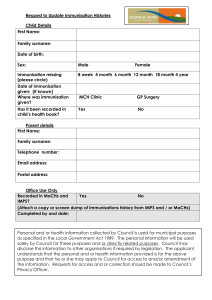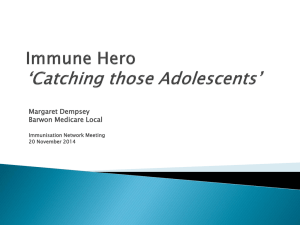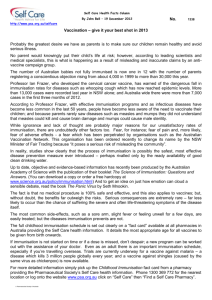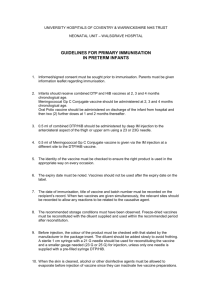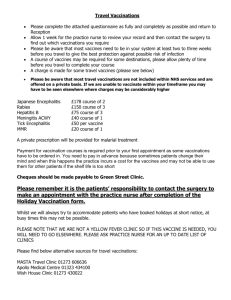Immunity and how vaccines work
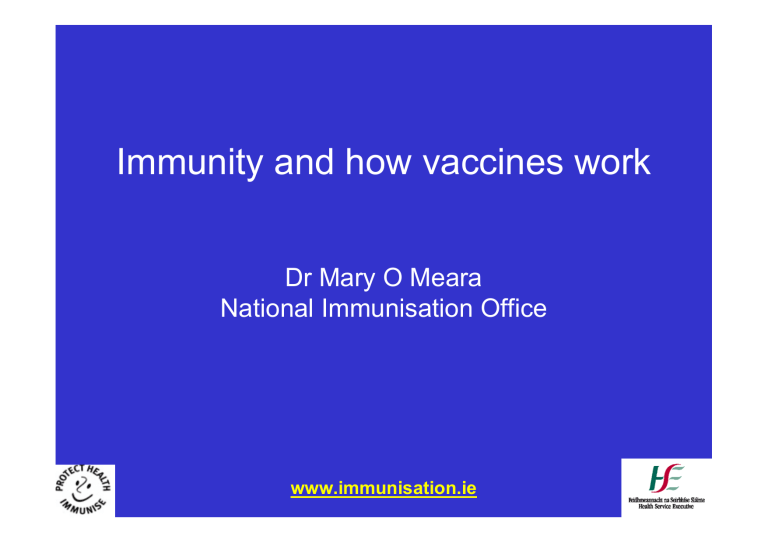
Immunity and how vaccines work
Dr Mary O Meara
National Immunisation Office www.immunisation.ie
Objectives of session
An understanding of the following principles
– Overview of immunity
– Different types of vaccines and vaccine contents
– Vaccine failures
– Time intervals between vaccine doses
– Vaccine overload
– Adverse reactions
– Herd immunity www.immunisation.ie
Immunity
– The ability of the human body to protect itself from infectious disease
The immune system
– Cells with a protective function in the
• bone marrow
• thymus
• lymphatic system of ducts and nodes
• spleen
• blood www.immunisation.ie
Types of immunity
www.immunisation.ie
Natural (innate) immunity
Non-specific mechanisms
– Physical barriers
• skin and mucous membranes
– Chemical barriers
• gastric and digestive enzymes
– Cellular and protein secretions
• phagocytes, macrophages, complement system
** No “memory” of protection exists afterwards ** www.immunisation.ie
Passive immunity – adaptive mechanisms
Natural
– maternal transfer of antibodies to infant via placenta
Artificial
– administration of pre-formed substance to provide immediate but short-term protection (anti-toxin, antibodies)
Protection is temporary and wanes with time (usually few months) www.immunisation.ie
Active immunity – adaptive mechanisms
Natural
• following contact with organism
Artificial
• administration of agent to stimulate immune response (immunisation)
Acquired through contact with an micro-organism
Protection produced by individual’s own immune system
Protection often life-long but may need boosting www.immunisation.ie
Antigen
A live or inactivated substance (e.g. protein or polysaccharide) capable of producing an immune response www.immunisation.ie
Antibodies
– Different types
• IgM, IgG, IgA, IgD, IgE
• Functions
– Neutralise toxins
– Block adhesion/cell entry of the antigen
– Neutralise and prevent viral replication
• Antigen specific
– Cannot cross-protect different type of microorganism www.immunisation.ie
Immune response following exposure to antigen
Primary response
• rapid
• mainly IgM
Secondary response
• faster and more powerful
• mainly IgG
How vaccines work
• Induce active immunity
– Immunity and immunologic memory similar to natural infection but without risk of disease
• Immunological memory allows
– Rapid recognition and response to pathogen
– Prevent or modify effect of disease www.immunisation.ie
Classification of vaccines
• Live attenuated
• Inactivated
– Whole cell
– Fractionated
• Protein based
– Toxoid
– Sub unit
• Polysaccharide
– Pure
– Conjugate www.immunisation.ie
Live attenuated vaccines
Weakened viruses /bacteria
– Achieved by growing numerous generations in laboratory
– Produces long lasting immune response after one or two doses
– Stimulates immune system to react as it does to natural infection
– Can cause mild form of the disease (e.g. mini measles which is non transmissible)
– CANNOT be given to immuno-compromised persons e.g. BCG/ MMR/ Varicella/ Yellow fever www.immunisation.ie
Inactivated vaccine and toxoids
• Cannot cause disease they are designed to protect against
• Doses
– Two of more doses plus booster doses usually required
• Whole
– Viruses (IPV, hepatitis A, influenza))
– Bacteria (whole cell pertussis)
• Fractional
– Protein-based
• Toxoid (diphtheria, tetanus)
• Subunit (Hepatitis B, acellular pertussis)
– Polysaccharide–based
• Pure
• Conjugate www.immunisation.ie
Polysaccharide vaccines
• Immunogenicity
– Less immunogenic than toxoids
– Response in children poor
• Duration of protection
– Does not provide lifelong immunity, booster often needed e.g.
– Pneumococcal polysaccharide vaccine
– Meningococcal ACWY polysaccharide vaccine (travel) www.immunisation.ie
Vaccine components
• Conjugating agents
– Carrier proteins which combine with antigens to improve immunogenicity
E.g. Men C, PCV, Hib
• Suspension fluid
– Fluid (water, saline, tissue-culture mixture)
• Preservatives, stabilisers, antimicrobial agents
– Trace amounts used to stabilise vaccine
– May cause allergic reaction www.immunisation.ie
Vaccine components
• Adjuvants
– Aluminium salt used to increase immunogenicity of vaccines containing inactivated micro-organisms or their products e.g.
• Hepatitis B vaccine
• Tetanus toxoid
• Diphtheria toxoid www.immunisation.ie
Vaccine components
• Thiomersal*
– Used in vaccine production since the 1930s
– Mercury containing compound used in some vaccines to prevent bacterial and fungal growth
– Also used as inactivating agent in early stage of production of some killed vaccines
– In 1999 EU and U.S. manufacturer’s decision to decrease thiomersal levels in vaccines
*also known as thimerosal www.immunisation.ie
Vaccine failure
• Primary
– Inadequate immune response to vaccine (e.g.MMR1)
– Infection possible any time post vaccination
• Secondary
– Adequate antibody response immediately after vaccination
– Level of antibodies decrease with time
– Booster doses usually required
– Feature of many inactivated vaccines www.immunisation.ie
Time intervals between vaccine doses
Antigen combination Recommended minimal interval between doses
≥ 2 killed antigens No minimum interval
Killed and live antigens No minimum interval
≥ 2 live antigens Four-week minimum interval if not administered simultaneously www.immunisation.ie
Time intervals between vaccine doses
• 2 Live vaccines - Minimum one month interval required
– Allows each immune response to develop
– Allows the next response to be a true secondary response – i.e. faster and bigger and with higher affinity IgG
– Diminishes immune interference www.immunisation.ie
Vaccine overload
• The human body is composed of 10 trillion cells and contains 100 trillion bacteria
On average there are
• 1000 bacteria on each cm 2 of skin
• 1,000,000 bacteria on each cm 2 of the scalp
• 100,000,000 bacteria per gram of saliva
• The maximum number of antigens in a vaccine was ~3000 (DTwP, most from wP)
• With the new vaccines this number is much lower still
• No evidence that vaccines can overload the immune system http://www.schoolscience.co.uk/content/4/biology/abpi/immune/immune3 www.immunisation.ie
Adverse events
• Live vaccines:
– frequency of adverse events falls with number of doses
– If antibody is made -> neutralises small amount of vaccine virus in any subsequent vaccine dose
– E.g. MMR
• Inactivated vaccines
– frequency of adverse events increases with number of doses
– Good antibody levels ->good secondary immune response
– May be inflammatory (i.e. produce a sore arm)
– E.g. tetanus, pertussis www.immunisation.ie
Herd immunity
• Only applies to diseases which are passed from person to person
• For each disease
– a certain level of immunity in the population which protects the whole population because the disease stops spreading in the community
• Provides indirect protection of unvaccinated as well as vaccinated individuals.
• May be the most important aspect of how vaccines work
– MMR given to infants protects pregnant women from rubella.
– Can eradicate disease even if some people remain susceptible http://www.immunisation.nhs.uk/About_Immunisation/Science/How_immunisation_works_-_animation www.immunisation.ie
Acknowledgements
Core Topic 2 Training slides,
Health Protection Agency, UK
,
Feb 2008 www.hpa.org.uk/web/HPAwebFile/HPAweb_C/1194947391135
Understanding vaccines,
National Institutes of Health, US Jan 2008 www3.niaid.nih.gov/healthscience/healthtopics/vaccine/PDF/undvacc.
pdf www.immunisation.ie

